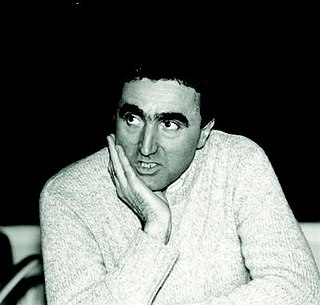Related Research Articles
Combinatorics is a branch of mathematics concerning the study of finite or countable discrete structures.

Doron Zeilberger is a mathematician, known for his work in combinatorics.
In mathematics, an alternating sign matrix is a square matrix of 0s, 1s, and −1s such that the sum of each row and column is 1 and the nonzero entries in each row and column alternate in sign. These matrices generalize permutation matrices and arise naturally when using Dodgson condensation to compute a determinant. They are also closely related to the six-vertex model with domain wall boundary conditions from statistical mechanics. They were first defined by William Mills, David Robbins, and Howard Rumsey in the former context.

Herbert Saul Wilf was an American mathematician, specializing in combinatorics and graph theory. He was the Thomas A. Scott Professor of Mathematics in Combinatorial Analysis and Computing at the University of Pennsylvania. He wrote numerous books and research papers. Together with Neil Calkin he founded The Electronic Journal of Combinatorics in 1994 and was its editor-in-chief until 2001.

Proofs from THE BOOK is a book of mathematical proofs by Martin Aigner and Günter M. Ziegler. The book is dedicated to the mathematician Paul Erdős, who often referred to "The Book" in which God keeps the most elegant proof of each mathematical theorem. During a lecture in 1985, Erdős said, "You don't have to believe in God, but you should believe in The Book."
In mathematics, and more specifically in analysis, a holonomic function is a smooth function of several variables that is a solution of a system of linear homogeneous differential equations with polynomial coefficients and satisfies a suitable dimension condition in terms of D-modules theory. More precisely, a holonomic function is an element of a holonomic module of smooth functions. Holonomic functions can also be described as differentiably finite functions, also known as D-finite functions. When a power series in the variables is the Taylor expansion of a holonomic function, the sequence of its coefficients, in one or several indices, is also called holonomic. Holonomic sequences are also called P-recursive sequences: they are defined recursively by multivariate recurrences satisfied by the whole sequence and by suitable specializations of it. The situation simplifies in the univariate case: any univariate sequence that satisfies a linear homogeneous recurrence relation with polynomial coefficients, or equivalently a linear homogeneous difference equation with polynomial coefficients, is holonomic.

Algebraic combinatorics is an area of mathematics that employs methods of abstract algebra, notably group theory and representation theory, in various combinatorial contexts and, conversely, applies combinatorial techniques to problems in algebra.

In mathematics, the Dyson conjecture is a conjecture about the constant term of certain Laurent polynomials, proved independently in 1962 by Wilson and Gunson. Andrews generalized it to the q-Dyson conjecture, proved by Zeilberger and Bressoud and sometimes called the Zeilberger–Bressoud theorem. Macdonald generalized it further to more general root systems with the Macdonald constant term conjecture, proved by Cherednik.

Louis Joseph Billera is a Professor of Mathematics at Cornell University.

Dominique Foata is a mathematician who works in enumerative combinatorics. With Pierre Cartier and Marcel-Paul Schützenberger he pioneered the modern approach to classical combinatorics, that lead, in part, to the current blossoming of algebraic combinatorics. His pioneering work on permutation statistics, and his combinatorial approach to special functions, are especially notable.
The progression of both the nature of mathematics and individual mathematical problems into the future is a widely debated topic; many past predictions about modern mathematics have been misplaced or completely false, so there is reason to believe that many predictions today will follow a similar path. However, the subject still carries an important weight and has been written about by many notable mathematicians. Typically, they are motivated by a desire to set a research agenda to direct efforts to specific problems, or a wish to clarify, update and extrapolate the way that subdisciplines relate to the general discipline of mathematics and its possibilities. Examples of agendas pushing for progress in specific areas in the future, historical and recent, include Felix Klein's Erlangen program, Hilbert's problems, Langlands program, and the Millennium Prize Problems. In the Mathematics Subject Classification section 01Axx History of mathematics and mathematicians, subsection 01A67 is titled Future prospectives.
In algebra and in particular in algebraic combinatorics, a quasisymmetric function is any element in the ring of quasisymmetric functions which is in turn a subring of the formal power series ring with a countable number of variables. This ring generalizes the ring of symmetric functions. This ring can be realized as a specific limit of the rings of quasisymmetric polynomials in n variables, as n goes to infinity. This ring serves as universal structure in which relations between quasisymmetric polynomials can be expressed in a way independent of the number n of variables.
In mathematics, a differential poset is a partially ordered set satisfying certain local properties. This family of posets was introduced by Stanley (1988) as a generalization of Young's lattice, many of whose combinatorial properties are shared by all differential posets. In addition to Young's lattice, the other most significant example of a differential poset is the Young–Fibonacci lattice.

In combinatorics, the Schröder–Hipparchus numbers form an integer sequence that can be used to count the plane trees with a given set of leaves, the ways of inserting parentheses into a sequence, and the ways of dissecting a convex polygon into smaller polygons by inserting diagonals. These numbers begin
Manuel Kauers is a German mathematician and computer scientist. He is working on computer algebra and its applications to discrete mathematics. He is currently professor for algebra at Johannes Kepler University (JKU) in Linz, Austria, and leader of the Institute for Algebra at JKU. Before that, he was affiliated with that university's Research Institute for Symbolic Computation (RISC).
The David P. Robbins Prize for papers reporting novel research in algebra, combinatorics, or discrete mathematics is awarded both by the American Mathematical Society (AMS) and by the Mathematical Association of America (MAA). The AMS award recognizes papers with a significant experimental component on a topic which is broadly accessible which provide a simple statement of the problem and clear exposition of the work. Papers eligible for the MAA award are judged on quality of research, clarity of exposition, and accessibility to undergraduates. Both awards consist of $5000 and are awarded once every three years. They are named in the honor of David P. Robbins and were established in 2005 by the members of his family.
Christoph Koutschan is a German mathematician and computer scientist. He is currently with the Johann Radon Institute for Computational and Applied Mathematics (RICAM) of the Austrian Academy of Sciences.
Stephanie van Willigenburg is a professor of mathematics at the University of British Columbia whose research is in the field of algebraic combinatorics and concerns quasisymmetric functions. Together with James Haglund, Kurt Luoto and Sarah Mason, she introduced the quasisymmetric Schur functions, which form a basis for quasisymmetric functions.
Aaron Robertson is an American mathematician who specializes in Ramsey theory. He is a professor at Colgate University.
References
- ↑ Ira Gessel's CV
- ↑ Putnam Competition Individual and Team Winners Archived 2014-03-12 at the Wayback Machine , MAA website.
- ↑ K. Luoto, S. Mykytiuk, S. van Willigenburg, An Introduction to Quasisymmetric Schur Functions Hopf Algebras, Quasisymmetric Functions, and Young Composition Tableaux , Springer, New York, 2013, p. vii.
- ↑ Profile of Ira Gessel, DLMF .
- ↑ Kauers, Manuel; Koutschan, Christoph; Zeilberger, Doron (2009-07-14). "Proof of Ira Gessel's lattice path conjecture". Proceedings of the National Academy of Sciences. 106 (28): 11502–11505. arXiv: 0806.4300 . Bibcode:2009PNAS..10611502K. doi: 10.1073/pnas.0901678106 . ISSN 0027-8424. PMC 2710637 .
- ↑ Bostan, A.; Kurkova, I.; Raschel, K. (2016-04-14). "A human proof of Gessel's lattice path conjecture". Transactions of the American Mathematical Society. 369 (2). American Mathematical Society (AMS): 1365–1393. arXiv: 1309.1023 . doi:10.1090/tran/6804. ISSN 0002-9947. S2CID 11810630.
- ↑ A. Gordon, Why Don’t We Have Pay Toilets in America?, Pacific Standard, Sep 17, 2014.